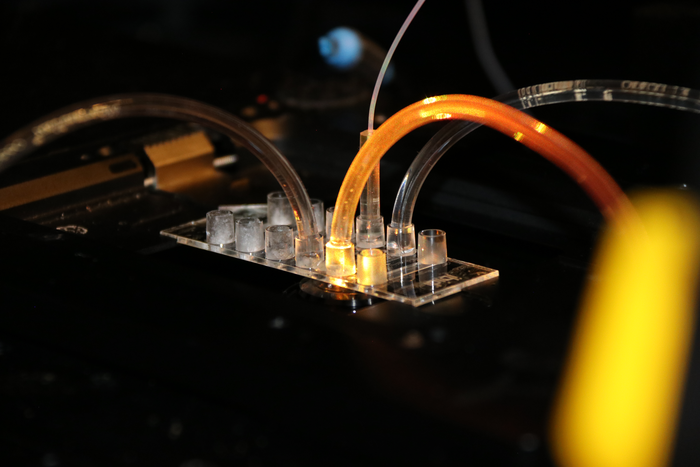High-throughput (HTP) combinatorial methodologies—which include microarrays, lab-on-a-chip systems, microfluidics, parallel pipetting, or robotic-assisted methodologies—are essential to accelerate synthetic biochemical technologies and discovery platforms. They can greatly minimize human input, and offer automated parallelized screening of small molecules. That said, they are often reliant on large-scale analyses which makes them limited by long running time and excessive materials costs.
Now, a team has presented a novel technique that allows the method to take place on the nanoscale, minimizing the use of materials and energy. The technique is a single-particle combinatorial multiplexed liposome fusion mediated by DNA for parallelized multistep and nondeterministic fusion of individual subattolitre nanocontainers. This new tool will speed up the development of vaccines and other pharmaceutical products by more than one million times while minimizing costs.
The work is published in Nature Chemistry in the article, “Single-particle combinatorial multiplexed liposome fusion mediated by DNA.”
The new method, called SPARCLD (single particle combinatorial lipidic nanocontainer fusion based on DNA mediated fusion) is a parallelized, multi-step, and nondeterministic fusion of individual zepto-liter nano-containers.
The research team has observed efficient (more than 93%) leakage-free fusion sequences for arrays of surface tethered target liposomes with six freely diffusing populations of cargo liposomes, each functionalized with individual lapidated DNA (LiNA) and fluorescent barcoded by distinct ratio of chromophores.
Stochastic fusion results in distinct permutation of fusion sequences for each autonomous nano-container. Real-time total internal reflection (TIRF) microscopy allowed direct observation of more than 16,000 fusions and accurate classification of 566 distinct fusion sequences using machine learning. The method allows for approximately 42,000 nano-containers per square millimeter.
More than 40,000 different molecules can be synthesized and analyzed within an area smaller than a pinhead. The method, developed through a highly interdisciplinary research effort in Denmark, promises to drastically reduce the amounts of material, energy, and economic cost for pharmaceutical companies.
The method works by using soap-like bubbles as nano-containers. With DNA nanotechnology, multiple ingredients can be mixed within the containers.
“The volumes are so small that the use of material can be compared to using one liter of water and one kilogram of material instead of the entire volumes of water in all oceans to test material corresponding to the entire mass of Mount Everest. This is an unprecedented save in effort, material, manpower, and energy,” said Nikos Hatzakis, PhD, associate professor at the department of chemistry, University of Copenhagen.

“Saving infinitely amounts of time, energy, and manpower would be fundamentally important for any synthesis development and evaluation of pharmaceuticals,” said Mette G. Malle, PhD, who worked on her PhD in the Hatzakis lab and is now a postdoctoral researcher at the Interdisciplinary Nanoscience Center at Aarhus University.
“No single element in our solution is completely new, but they have never been combined so seamlessly,” explained Hatzakis. The breakthrough involves the integration of elements from normally quite distant disciplines: synthetic biochemistry, nanotechnology, DNA synthesis, combinational chemistry, and machine learning.
“What we have is very close to a live read-out. This means that one can moderate the setup continuously based on the readings adding significant additional value. We expect this to be a key factor for industry wanting to implement the solution,” said Malle.
When considering possible applications, Hatzakis noted, “A safe bet would be that both industry and academic groups involved in synthesis of long molecules such as polymers could be among the first to adopt the method. The same goes for ligands of relevance for pharmaceutical development. A particular beauty of the method is that it can be integrated further, allowing for direct addition of a relevant application.”
For example, RNA for CRISPR, or an alternate for screening, detecting, and synthesizing RNA for future pandemic vaccines.






